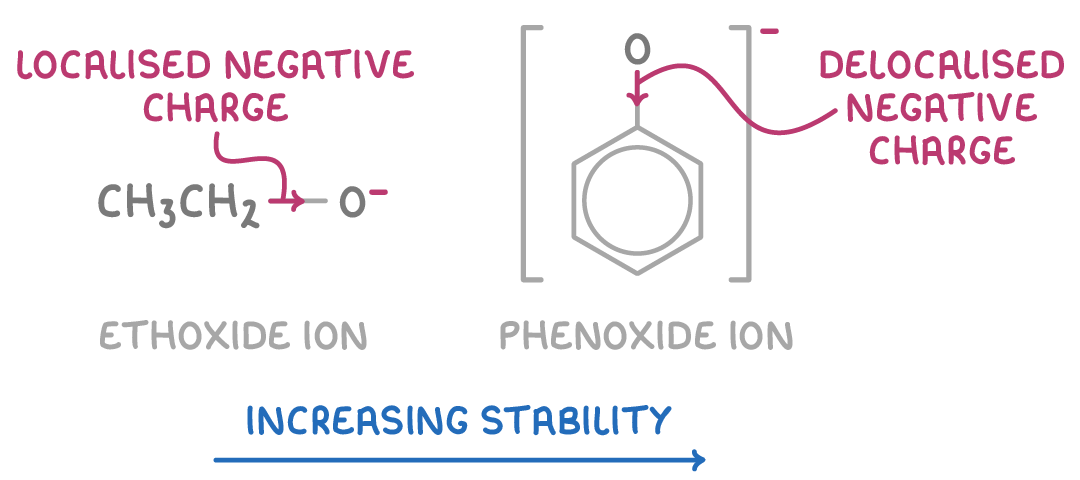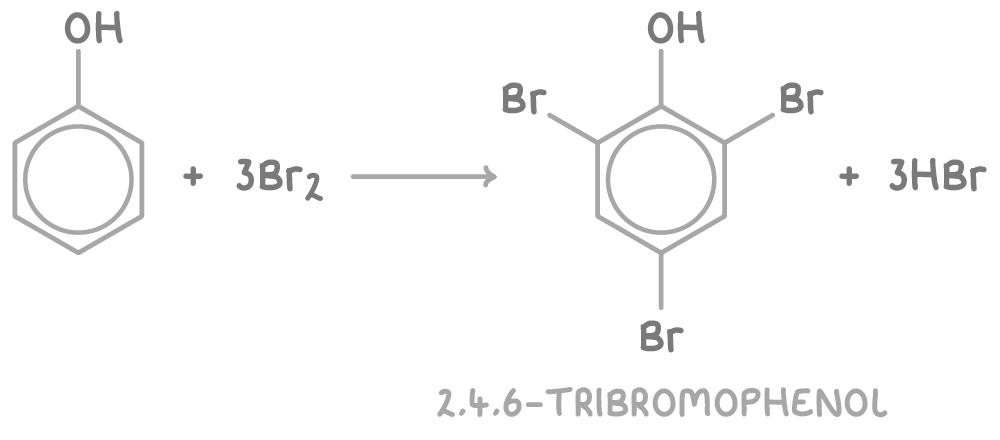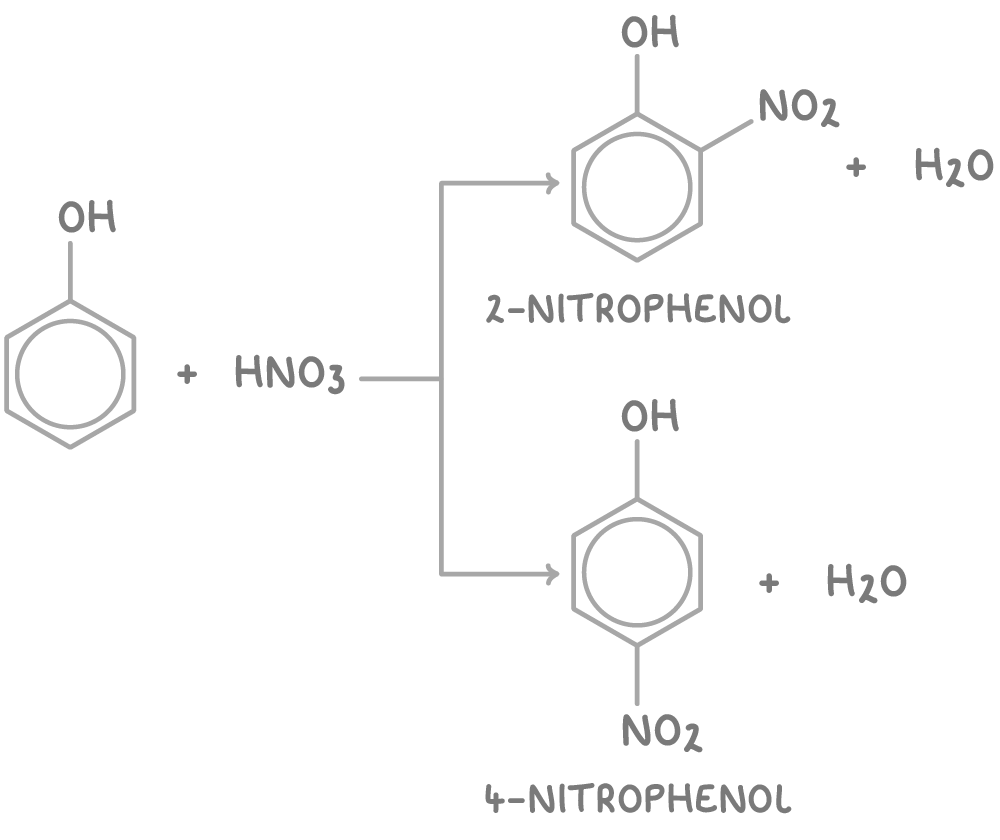Phenol
This lesson covers:
- The structure of phenols
- Why phenols are more reactive than benzene
- Preparing phenol from phenylamine
- The acidity of phenols
- Reactions of phenols
Phenols contain benzene rings with -OH groups
Phenol has the formula C6H5OH. The key structural feature of a phenol is an aromatic benzene ring attached to a hydroxyl (-OH) group.
Other phenolic compounds have additional substituents bonded to the benzene ring.
The skeletal formula of phenol is:

Phenol is more reactive than benzene
Phenol is more reactive towards electrophilic substitution than benzene because:
- The electron-donating -OH group activates the aromatic ring, making it more susceptible to electrophilic attack.
- One of the lone pairs of electrons in a p-orbital of the oxygen atom overlaps with the delocalised π system of electrons in the benzene ring.
- This allows the lone pair to partially delocalise into the aromatic π system, increasing the electron density within the ring.
- A higher electron density makes the ring more reactive towards electrophiles.
Preparing phenol via diazotisation
Phenol can be synthesised from phenylamine through a two-step reaction sequence.
Step 1 - Diazotisation
Initially, nitrous acid (HNO2) is produced in situ by reacting sodium nitrite with dilute HCl at temperatures below 10°C:
NaNO2(s) + HCl(aq) ➔ HNO2(aq) + NaCl(aq)
Subsequently, nitrous acid reacts with phenylamine in an electrophilic substitution to form a diazonium salt, specifically benzenediazonium chloride:

Step 2 - Decomposition
The diazonium salt, being unstable, is gently warmed in water to decompose, yielding phenol:

Phenol is a stronger acid than water and ethanol
As a weak acid, phenol can lose H+ from its -OH group, illustrated by the equilibrium:
C6H5OH ⇌ C6H5O- + H+
The acid strengths of phenol, water, and ethanol are comparable through their pKa values:
| Acid | Dissociation | pKa at 298 K |
|---|---|---|
| Phenol | C6H5OH ⇌ C6H5O- + H+ | 10.0 |
| Water | H2O ⇌ H+ + OH- | 14.0 |
| Ethanol | C2H5OH ⇌ C2H5O- + H+ | 16.0 |
Hence, the acidity increases as follows:
ethanol < water < phenol
This sequence is explained by the relative stability of each acid's conjugate base upon dissociation.

Phenoxide ion:
- Post-dissociation, the negative charge becomes delocalised over the aromatic ring system.
- The phenoxide ion's lone pair overlaps with the benzene π system, spreading the charge and enhancing stability.
Ethoxide ion:
- The ethyl group's electron-donating effect concentrates the negative charge on the oxygen atom, reducing stability.
- The high charge density prompts the ethoxide ion to readily accept an H+, reforming neutral ethanol.
The increased stability of the phenoxide ion, with its delocalised negative charge, accounts for phenol's greater acidity compared to water and ethanol.
Reactions of phenols
With bromine water:
- Phenol causes bromine water to decolourise as substitution occurs at the 2- and 4- positions, producing 2,4,6-tribromophenol as a white precipitate.

With dilute nitric acid:
- Direct nitration of phenol yields two main isomers, 2-nitrophenol and 4-nitrophenol, at the 2- and 4- positions respectively.

With bases:
- Phenol reacts with NaOH(aq) in a neutralisation reaction to form sodium phenoxide and water:
C6H5OH + NaOH ➔ C6H5ONa + H2O
- Phenol does not react with Na2CO3(aq) due to its relatively weak acidity.
To distinguish a phenol from a carboxylic acid, you can test its reaction with sodium carbonate (Na2CO3); phenols do not react with Na2CO3, while carboxylic acids do to produce effervescence due to the release of carbon dioxide gas.
With sodium:
- Sodium metal reacts vigorously with molten phenol, producing sodium phenoxide and hydrogen gas:
C6H5OH + Na ➔ C6H5ONa + 1⁄2H2
With diazonium salts:
- Under alkaline conditions, phenol reacts with diazonium salts (formed from the diazotisation of phenylamine) to produce brightly coloured azo dyes.
- The reaction involves an electrophilic substitution between the phenolate ion and the diazonium ion, resulting in the formation of an azo group (N=N) that connects the two aromatic rings:

Bromination and nitration of phenol requires milder conditions than benzene
The presence of the -OH group in phenol activates the aromatic ring, enhancing its electron density and allowing for electrophilic attacks under more moderate conditions than required for benzene. This characteristic explains why phenol undergoes electrophilic nitration and bromination more readily.
The reaction conditions for both benzene and phenol during bromination and nitration illustrate the differences in their reactivity:
| Reaction | Benzene | Phenol |
|---|---|---|
| Bromination | Br2, FeBr3 catalyst, room temperature | Br2(aq), room temperature |
| Nitration | Conc. HNO3, conc. H2SO4, heat | Dilute HNO3, room temperature |